
Wild Turkey Population Dynamics and Brood Survival Project Report for May 2022
Provided by Oklahoma Cooperative Fish and Wildlife Research Unit, Oklahoma State University
Wild turkey genetics is among the areas of a 4.5-year study launched at the beginning of 2022 by the Oklahoma Department of Wildlife Conservation and the Oklahoma Cooperative Fish and Wildlife Research Unit to address wild turkey population dynamics and brood survival.
In May, project researchers met with Oklahoma Department of Wildlife Conservation personnel and collected spring 2022 harvest samples. Over the course of the spring hunting season, about 125 samples were obtained through all contributors, including ODWC, National Wild Turkey Federation state chapters, and the Cherokee and Muskogee Nations. Tissue samples have been cataloged and stored in preparation for DNA extraction during the coming months.

Southeastern Study: Researchers observed nine nesting attempts by seven radio-marked hens. Two were re-nesting attempts following nest failure on first attempts. Four of the nine nests were actively incubated at the end of May and were being monitored. Hatching is expected in mid-June. Of the remaining five nests, one was abandoned, one was depredated by a mammal, and one successfully hatched. The fate of the remaining two nests was unknown, as they were on private property to which the landowner denied access to researchers.
Following the successful hatch May 20, researchers captured three of six poults from that brood and fitted them with suture-style VHF transmitters. The poults were monitored daily for survival, and all three were alive and with the hen at the end of May. In addition to monitoring hens, nests, and poults, researchers completed vegetation sampling at nest sites with known fates.
Southwestern Study: Researchers met with Wildlife Department personnel and regional Game Wardens at Sandy Sanders Wildlife Management Area about potential trapping sites and land access, and toured some potential trapping areas. Researchers continued developing research ideas.
(This project is funded in part by the Oklahoma Department of Wildlife Conservation's Wildlife Restoration Grant Program, Federal Aid Project F21AF02702.)